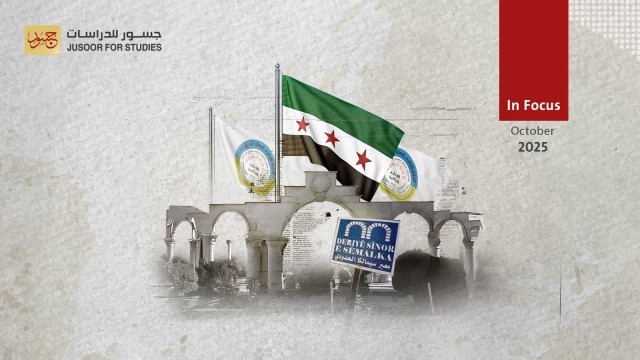The Israeli Counter-Iran Strategy in Syria
written by Obaida Fares Senior researcher at Jusoor for Studies
Israel saw an opportunity in the Iranian support of the Syrian regime during the first year of the revolution to deplete both. Iran’s deployment of large numbers of Revolutionary Guards, along with Lebanese, Iraqi and other militias, transformed this perceived opportunity into a threat that required intervention.
At that point in time, Israel adopted a set of double policies; the first was a military policy by carrying out key strikes mostly targeting Iranian military convoys heading to Lebanon; the second was political, as it pushed to prolong the crisis, prevent any single party from achieving victory, to exhaust the Iranians as much as possible and weaken the regime to render it a non-threat to neighboring states. Simultaneously, Israel sought to prevent the regime’s downfall on the basis the regime has been proved the guard that Tel Aviv does not want to risk replacing.
The conflict in Syria entered a new phase with the Russian military intervention in 2015 in support of the Assad regime. Russia’s intense targeting of opposition factions contributed to providing Iran and its partners with more impetus to maneuver. Thereby, the Russian intervention forced Israel to change its approach, given that Russia can restrict the Israeli military offensives as it finds appropriate based on its assessment of developments.
During this period, the Israeli strategy depended on the broad lines of what is known as the “battle between wars” strategy, within a broader scope that includes outlining the major goals that Israel seeks to achieve in the conflict in Syria. For Israel, the most important goals are: limiting Iranian and Russian influence in Syria; stopping the transfer of advanced weapons to Hezbollah; preventing Syria from becoming a real military threat to Israel or allow Iran to do so; undermining the legitimacy of Syrian demands for the return of the Golan Heights; preventing Sunni militias from building infrastructure or bases for their operations along the Israeli border.
With Naftali Bennett taking the position of Minister of Security, the Israeli strategy shifted from the defensive to the offensive whereby, it moved from reacting to Iranian threats located across Syria to strategic action by targeting Iran partners e.g. Hezbollah, Hamas ...) to impact Iran.
In general, it appears that the Israeli strategy of not interfering during the first years of Iranian intervention in Syria, and then relying on limited key strikes, has failed to limit the Iranian influence. It appears that Iran has generally succeeded in turning the threat it faced in 2011 into a real opportunity as is reflected in the transformation in its relationship with the Syrian regime. Iran now controls the joints of the Syrian state after it was only an external ally with limited social, religious or economic presence in the Syrian society.
The organic relationship that has developed between Iran and al-Assad regime reflected on Israel’s policies in dealing with the regime. Israel was no longer able to separate Iran from the regime, so it changed its approach as weakening Iran required weakening the regime, or even changing it.
It is expected that Iran will not relinquish its role in Syria, despite Israeli and American pressures. However, based on the new variables it is facing including the economic sanctions imposed on it, the sanctions imposed on its allies based on Caesar’s Law and the absence of Qassem Soleimani, the architect of Iran’s expansionist project in the region, Iran’s insistence on its continued role in Syria makes it very costly. A critical shift in Iran’s position will provide an opportunity for other competitors in the region, including Israel, to take advantage and, in effect, Iran’s gains may turn into a burden that the Iranian affiliates cannot carry.
Click to Download the Arabic version PDF








